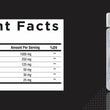Core Nutritionals Shred


Regular price $39.99
Unit price per
Non-Stimulant Thermogenic Powder
Increases Lipolysis Without Stimulants
-
1 scoop per serving
-
56 servings per container
-
Healthy thyroid support


